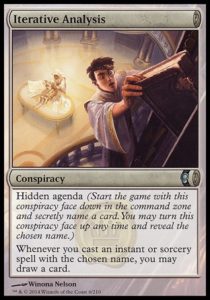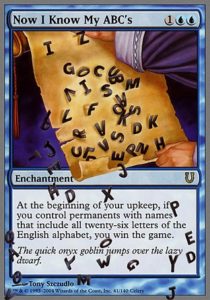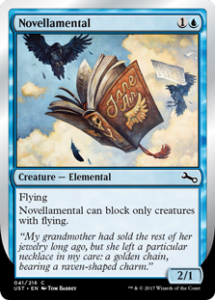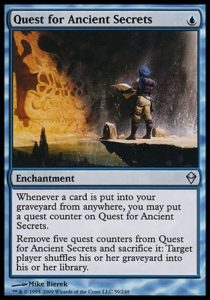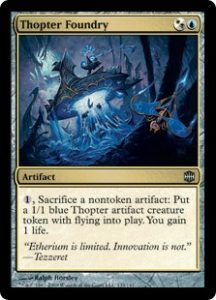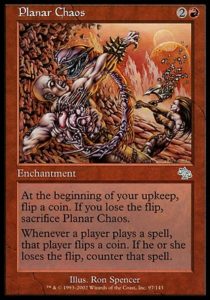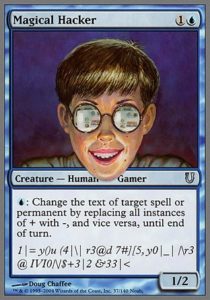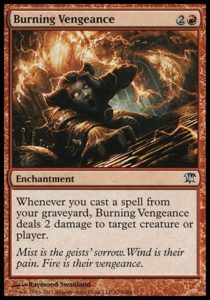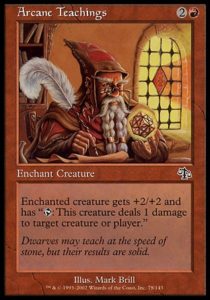Welcome back to Great Designer Training, where we all prepare to compete in and enjoy GDS3 together! There’s a lot of stuff to get to this week, so first things first: a big shout out to our comrades in arms at Goblin Artisans and MTGColorPie’s GDS3 subreddit. The community has been rallying together to prepare for GDS3 (after a frenzied weekend of playing Unstable), which is deeply heartening. Check out those resources, as well as our design prep right here at Hipsters of the Coast!
As a reminder, if you haven’t signed up for GDS3 and want to, you can sign up here. If you signed up on the very first day of GDS3, there was a server error and you need to sign up again (cue people frantically sending multiple entries).
We’ll conclude this article with the results of last week’s design tests. But first, here are this week’s new design assignments!
Research Assignment: Unkeyworded Keywords and Unnamed Ability Words
Magic keywords and ability words are the lifeblood of the game. Every set needs to introduce something new and to call attention to it by adding to the vocabulary of Magic. (Failing to do this was a major mistake in Masques block.) Wizards has discovered that its previous successes can not only be brought back as major set mechanics (often with a twist), but it can also subtly bring them in for cameo appearances. For example, Kaladesh’s Gearseeker Serpent has Affinity for Artifacts without actually saying that it has Affinity for Artifacts.
Your assignment is to find three cards that have keywords or ability words without actually having those named mechanics in their text. Furthermore, they must have been printed after that mechanic came out (for example, Goblin War Drums doesn’t count, since it was created over twenty years before Menace became keyworded).
As a secondary assignment, brush up on the difference between keywords and ability words (hint: the placement of italics can be quite helpful).
Callback Assignment: GDS#2 Question 6
This is the most incorrectly-answered question of GDS 2, with just under 9% of all test takers getting it correct. (Deflecting Mage is a hypothetical creature with flash and Deflection as it’s ETB ability.) Can you figure out the correct answer?
6) Design often makes creatures that have flash and “enters the battlefield” triggered abilities like Deflecting Mage. Which of the following abilities would we least likely pair with flash?
a) Counter target spell.
b) The next time target instant or sorcery spell would deal damage, it deals double that damage instead.
c) CARDNAME deals 2 damage to target attacking or blocking creature.
d) Prevent all combat damage that would be dealt this turn.
e) Target creature gets +3/+3 until end of turn.
GDS-esque Questions
Question #1: Which colors are able to “tutor” (search their library for a card and put it into their hand) for a basic land?
a) Green
b) White and green
c) Black and green
d) White, black, and green
e) All five colors
Question #2: R&D makes sure that each limited environment has one or more mechanics that help gameplay to ensure better consistency and/or smooth mana bases. Which of the following mechanics least meets this need? (Writer’s note: you may recognize this text. It’s copied from GDS1. The answers, however, are not.)
a) Scry
b) Explore
c) Landfall
d) Flashback
e) Outlast
Question #3: Which of the following is NOT an example of a parasitic mechanic?
a) Energy
b) Convoke
c) Poison
d) Aftermath
e) Affinity
Design Challenge
Commons are the lifeblood of Limited and the cornerstone of Magic’s worldbuilding. They introduce a set’s most important mechanics while conforming to New World Order. Design the following five commons:
- An Innistrad creature with a reprint keyword/ability word never before seen in an Innistrad block.
- An Izzet League instant or sorcery.
- A reprint for Theros that makes sense on the world.
- A five-mana aura.
- An artifact with a colored activation cost for Kaladesh.
As a bonus research question, brush up on what New World Order is. It’s very commonly misunderstood on Blogatog and I expect there to be questions in GDS3 to prey upon that.
Happy Designing!
I was delighted to see so many entries last week and hope we can get even more this week. You can submit your responses here.
I encourage you to post your ideas and thoughts elsewhere, as well—perhaps at Goblin Artisans or the GDS3 subreddit, as linked above. That said, I’d like to continue with this format—it lets people avoid public forums, either for the sake of privacy, personal preference, or avoiding seeing other folks’ ideas until they’ve finished crafting their own. And now, let’s get to last week’s questions!
Color Pie Chaos
Harmonize was probably the most commonly referenced color-pie violator. It’s one of the most powerful such cards in Planar Chaos and has seen the most printings. And yes, it’s totally a color pie break—green may be secondary in card drawing, but it doesn’t get card advantage without it being tied to another resource.
Mana Tithe is quite the quandary. White certainly gets taxing in effects like Thalia, Guardian of Thraben, and Lapse of Certainty suggests that white can, very rarely, get to counter spells by delaying them. However, actually countering spells (without making them fizzle) is the pure purview of blue. White doesn’t do this.
Aether Membrane was an unexpectedly popular response. Yes, red can get defensive cards, and red has recently become secondary in reach. However, red still doesn’t get bounce (even if it’s something folks are hoping for). The Membrane even (sort of) covers red’s weakness at killing big creatures for low mana costs.
There were a ton of correct answers, from the obvious breaks of Giant Dustwasp and Reality Acid to the subtler bends of Ridged Kusite (black is tertiary at First Strike and shouldn’t be giving it out at common) and Needlepeak Spider (red didn’t get Reach at the time).
I encourage everyone to check out Mark Rosewater’s Mechanical Color Pie article from earlier this year. GDS3 is likely going to require a more thorough understanding of the color pie than previous ones. After all, there’s more comprehensive information about it than ever before.
Callback Assignment: GDS#1 Question 7
(Writer’s note: the original article originally listed this question as being from GDS#2. Sorry about that.)
Card Loving Guy
???
Creature – ???
3/3
First strike
Whenever CARDNAME deals damage to an opponent, draw a card.
#7) Of the following choices, what is the most appropriate color for the above card?
a) white/black
b) blue/black
c) black/green
d) red/green
e) red/white
I originally guessed B, since blue obviously has the Ophidian ability and black certainly has First Strike (because Black Knight had just been reprinted at the time of GDS2).
The trick to this question is recognizing the difference between a color being secondary and tertiary in a mechanic: a color cannot grant a mechanic it is tertiary in to a multicolored card. Black is tertiary in First Strike, so even though a monoblack card can have First Strike, a multicolored card that is neither white nor red cannot have First Strike.
Green has had the Ophidian ability since Hystrodon and continues to have it today with cards like Sixth Sense. Red and white are both primary in First Strike. Therefore, D is the correct answer.
Color Pie Shift
#1: Dash
This question is obliquely asking what colors have access to haste. Red is primary, black is secondary, and green is tertiary. Therefore, green is the correct answer.
White feels like it could get dash—it’s an aggressive color and the Mardu are an alternate universe Kolaghan clan. However, white just doesn’t get haste. There’s an argument to be made that Dash also involves self-bouncing, which white is secondary at. However, green is also secondary at self-bouncing.
#2: Annointed Procession
The answer to this is also green. Green is primary in tokens (along with white). In fact, green already had Annointed Procession in both Parallel Lives and Doubling Season. This question was designed to test if folks were familiar with recent design history and if they’d research the questions before answering. (That’s a thing you’ll be able to do for GDS!)
There were some very cool arguments for both blue (which copies creatures) and red (which does so temporarily). I think those colors could have token doubling under certain circumstances, but green is primary in token generation.
#3: Aerial Responder
This was (intentionally) a tricky question. Lifelink is only in two colors, white and black. Vigilance is only in two colors, white and green. The correct answer is none. No color other than white has access to both keywords. Aerial Responder can only be a monocolored card if it’s white. This question was designed to test if folks would recognize little lines of text like “if any.” There are ‘gotcha’ GDS questions and you need to read them closely.
Design Challenge
My favorite design was actually submitted by two different designers: Paul Smith and Jake.
Paul Smith’s Check this out! We found some blood!
1WB
Enchantment
At the beginning of your end step, if you gained life this turn, you may pay 1. If you do, create a 1/1 white vampire soldier creature token with lifelink.
Jake’s Aroma of the Feast
WB
Enchantment
At the beginning of your end step, if you gained life this turn, create a 1/1 white Vampire creature token with lifelink.
These are simple, straightforward designs (of quite different power levels, but that’s less important). The flavor is clear and consistent with Ixalan’s vampires: they are attracted to the scent of blood and like to hang out with each other. These enchantments serve to bolster vampires—which, in my opinion, are kind of lacking much of a reward for lifegain other than lifelink being a generally strong ability. They work well with themselves, but they need something to rev them up. I could even see a more powerful version to really reward players for going in on life gain:
Call to the Vein
2WB
Enchantment
At the beginning of each end step, if you gained life this turn, create a 1/1 white Vampire creature token with lifelink.
1B, sacrifice a nontoken creature: You gain 3 life.
This version is a bit more expensive to offset the lack of a mana payment for a token and the possibility of never-ending 1/1 lifelinking blockers. But, it can start the token generation by itself, semi-blanks removal, and it works on every turn. It’s still not something I’d be as excited to play as Burning Vengeance, but it’s a nifty design. All credit goes to Jake and Paul Smith for their inspirational, elegant designs.
My entry for this challenge focused on something several other designs did (and also my least favorite mechanic in Ixalan): Explore.
Friendly Fish Finders
1G
Enchantment
Whenever a creature you control explores, create a 1/1 blue Merfolk creature token with hexproof.
5G: Target creature explores. Activate this ability only any time you could cast a sorcery.
Phew! That’s all for this week. Thanks for all of your wonderful designs and insight—I’m sorry I could only respond to and post a few of them. Please, keep ’em coming and share them elsewhere, as well! May we all make this the hardest GDS3 for WotC ever!
—Zachary Barash
Zachary Barash is a New York City-based game designer. He works for Kingdom Death: Monster, has an MFA in Game Design from NYU, and does freelance game design. Also, when the stars align, he streams.
His favorite card of the month is Explore, his favorite Magic card design ever. It’s so beautifully efficient. It imparts a knowledge and perhaps introduces you to a new land, just like exploration does. It’s powerful, but fair, and yet it’s also kind of Time Walk for the exact same mana cost.

